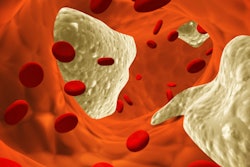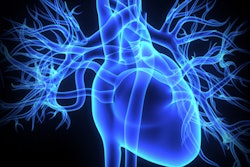
Radiomics analysis of coronary CT angiography (CCTA) exams found that cardiovascular risk factors such as cocaine use and HIV affect development of atherosclerosis in different ways, according to a February 16 study in Radiology.
In 300 patients with subclinical coronary artery disease (CAD), CCTA radiomics revealed that cardiovascular risk factors such as cocaine use, HIV infection, and elevated atherosclerotic cardiovascular disease risk scores resulted in distinct -- and nonoverlapping -- morphological changes in coronary atherosclerosis over a four-year follow-up period.
"To our knowledge, our results are the first in vivo findings that suggest effects of different exposures on CAD may be distinguishable from each other," wrote the researchers, which included first author Dr. Márton Kolossváry, PhD, of Johns Hopkins University and lead author Dr. Shenghan Lai of the University of Maryland and Johns Hopkins University. "This implies that rather than having a complex interconnected network of factors contributing to the development of atherosclerosis, the effects of different risk factors may correspond to specific known or unknown pathways of disease progression."
Seeking to assess how different cardiovascular risk factors contribute to changes over time in plaque morphology, the researchers randomly sampled 300 patients who were enrolled in prospective epidemiologic observational studies and who had confirmed subclinical CAD on CCTA. Of the 300 patients, 226 were infected with HIV and 174 were cocaine users. All participants were followed for an average of four years, and they had two CCTA exams at least one year apart.
To perform radiomics-based precision phenotyping, the researchers extracted and quantified 1,276 radiomic features for each plaque using version 1.4.0.2 of QAngioCT 3D workbench software (Medis Medical Imaging Systems) and evaluated changes in these features over time.
After conducting univariate analysis, the researchers found the following risk factors associated with changes in radiomics features over time:
| Association of risk factors with change in CT radiomics features | |
| Risk factor | Prevalence |
| Cocaine use | 23.7% |
| Elevated atherosclerosis cardiovascular disease | 8.2% |
| HIV infection | 1.3% |
Delving further into the results, the researchers found no overlap between the radiomics parameters associated with cocaine use, HIV infection, or elevated atherosclerotic cardiovascular disease risk. They also found 13 clusters among the 409 radiomics parameters associated with the cardiovascular risk factors. Of these, eight clusters were affected only by cocaine use and three were affected only by atherosclerotic cardiovascular disease risk.
From their analysis, the researchers concluded the following:
- Different risk factors may contribute distinctly to the temporal changes in plaque morphologic features.
- Patient sex may not only affect the magnitude of CAD but also modulate the effects of risk factors on the disease. Different phenotypes by sex may potentially explain sex differences in adverse cardiovascular outcomes.
- Risk factors may have different effects throughout life. For example, HIV infection had a more profound effect on structural changes of CAD in younger individuals than in older participants.
- Complex interactions may be present between risk factors, potentially increasing or decreasing the effects of each other. For example, the researchers found that the effects of cocaine use were present only in individuals with elevated atherosclerotic cardiovascular disease risk.
Radiologic imaging offers a unique opportunity to assess the temporal changes in disease processes, helping to improve understanding how different risk factors affect the disease course, according to the researchers.
In an accompanying editorial, Dr. Joseph Schoepf and Dr. Tilman Emrich of the Medical University of South Carolina noted that the study's insights into plaque characteristics must still prove their clinical relevance, benefits in treating CAD, and prognostic value. However, the research results offer a window into a "brave new world" in which advanced image analysis-based phenotyping may inspire new avenues for basic science research, they said.



















